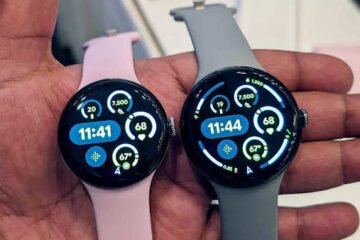Taking a look back at seven days of news and headlines across the world of Android, this week’s Android Circuit includes Samsung’s new desktop mode for the Galaxy S8, two possible designs for the S8, the return of the Galaxy Note, how to fix the Google Pixel, BlackBerry’s return at CES, new fitness goals in Google Calendar, OnePlus release Nougat based Oxygen OS, and a new guide to Material Design.
Android Circuit is here to remind you of a few of the many things that have happened around Android in the last week (and you can find the weekly Apple news digest here).
Galaxy S8 Delayed
Time to alter your diaries. Samsung has traditionally revealed the flagship Galaxy handsets at MWC, but 2017 could see a change to that plan. Thanks to the time needed to investigate the issues with the fiery Note 7, the Galaxy S8 is going to arrive later in the year.
The information arrives via Korea thanks to the ever vigilant SamMobile and says Samsung could well skip its regular unveiling spot at Mobile World Congress in February. Instead Samsung is thought to be considering a separate event in New York in March with the Galaxy S8 subsequently not going on sale until April 18th.
More on the launch details here.
Samsung Fighting Mobiles On The Desktop
Samsung continues to look for every advantage it can for its upcoming flagship handset. Following the leak of a ‘new features’ presentation, it looks like the South Korean company is ready to challenge Windows 10 Continuum feature where a smartphone can act as a standalone computer with an external monitor, keyboard, and mouse. Reported on by AAWP’s Steve Litchfield, this is Samsung’s Desktop Experience.
You might raise an eyebrow on why a Windows Phone site is reporting this story, but that becomes clear when you realise what Samsung’s Desktop Experience is. By allowing the Galaxy S8 to connect to a monitor, keyboard and mouse, the Android-powered handset can create a new ‘Extended Workspace’ that in effect creates a desktop environment driven by the handset.
That’s a direct play into the same space as Microsoft’s Continuum which allows a Windows 10 Mobile handset to drive a monitor, keyboard, and mouse. This replicates the Windows 10 desktop using the portable device. The pitch being that if you have a Windows 10 device you don’t need to cart a laptop as well, just a keyboard and mouse and an HDMI cable to attach a screen (such as the one in most hotel rooms).
My thoughts on the subject can be found here on Forbes.

People walk past an advertisement for the Samsung Galaxy S7 Edge smartphone. (Photo by Sean Gallup/Getty Images)
Are There Two Galaxy S8 Designs?
One more decision Samsung has to make over the flagship family is to go with a single handset with its recognisable curved screen, or to have two different models as it did with the Galaxy S7 and the S7 Edge. The latest rumors suggest that the South Korean company is considering a dual-model approach:
…launching two models for the S8 family makes more corporate sense. Samsung needs to have a successful launch after the Note 7, it needs to appeal to as wide a range of customers as possible to make up for the lost sales of the phablet, and it needs to retain a foothold in the enterprise market.
It has proven that it can ship two ‘S’ models previously to critical and commercial success, it has the back-end knowledge of dealing with vast numbers of different models and SKU’s and it has the experience of managing a lunch with two distinct models.
I can see the attraction of a Galaxy S8 and an S8 Edge.
This Is How The Note Returns
Neither is Samsung ready to give up on the Galaxy Note brand just yet. There are indications that the popular phablet line will rise phoenix-like from its fiery recall with refreshed clarity. And that clarity will be seen in a 4K display. Forbes’ Gordon Kelly reports:
4K is held up by many as the key resolution phones will need if they are to provide a viewing environment that is comfortable for long periods when the device is positioned so close to the eyes. And if any device can take a 4K display and bolt on the sizeable battery required to keep it running, it’s the famously long lasting Note range.
Needless to say it would also give Samsung a headline grabbing aspect to the Galaxy Note 8. Especially if it follows recent release schedules and debuts before the overhauled OLED iPhone 8 making its competition the ageing 750p and 1080p LCD panels in the iPhone 7 and iPhone 7 Plus.
Read more here on Forbes.

Members of the media examine Google’s Pixel phone during an event to introduce Google hardware products (Photo by Ramin Talaie/Getty Images)
Fixing The Pixel
The critically acclaimed Google Pixel is a popular device with the geekerati, but it’s not perfect (let’s be honest, which smartphone ever is?). Ryan Whitwam picks up on some of the areas where Google could improve the design (presumably for the Pixel 2 and Pixel 2 XL later in the year) starting with water resistance:
The Pixel is a very sturdy phone with a thick aluminum frame and magnesium mid-frame, but get it a little wet and it might not matter. Unlike some other phones in this price range, the Pixel is not water resistant. At least not really. It’s rated IP58, meaning it can take a little splash, but drop it in water or take it out in heavy rain, and you’ll have a bad time….
It’s not like water-resistant phones are rare anymore. Google might have simply been pressed for time when making the Pixel after Huawei pulled out of the program. However, it’s possible to make a phone that looks good and is water resistant. Look at the Galaxy S7. The age of port covers is over. Google needs to step up its water-resistance game.
[Source:-Forbes]




